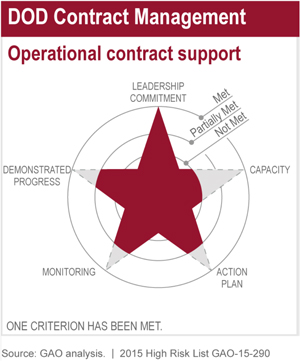Contractors in Iraq & Afghanistan
At the peak of combat operations in Iraq and Afghanistan, the number of military contractors sometimes met or exceeded the number of U.S. military personnel in service. Since then, contracted support in these areas has decreased, but contractors continue to play an important role in sustaining U.S. forces abroad. To help understand how the Department of Defense (DOD) oversees these contractors, today’s WatchBlog shines a light on operational contract support (OCS).
What Is Operational Contract Support (OCS)?
As we’ve reported, the OCS process helps ensure that the billions of taxpayer dollars spent on military contracting go to the right people, and are appropriately accounted for. This process consists of 3 steps the U.S. military uses to properly integrate contracted support into military operations:
- Planning. Overseas operations are inherently uncertain, but effective planning for operational contract support by DOD can help reduce the risks posed by those uncertainties.
- Obtaining supplies, services, and construction. This can include everything from mess halls to fuel supply to mechanics.
- Managing the commercial contractors. DOD is supposed to oversee contractors, and integrate their personnel and equipment into operations.
Opportunities to Improve OCS Oversight
 We have identified long-standing issues in DOD’s use of contractors, including those in Iraq and Afghanistan. OCS is a major part of the DOD Contract Management area on our High Risk List. Issued at the start of each new Congress, this list highlights federal programs at high risk for waste, fraud, abuse, or mismanagement, or are in need of broad-based transformation.
We have identified long-standing issues in DOD’s use of contractors, including those in Iraq and Afghanistan. OCS is a major part of the DOD Contract Management area on our High Risk List. Issued at the start of each new Congress, this list highlights federal programs at high risk for waste, fraud, abuse, or mismanagement, or are in need of broad-based transformation.
With recent and upcoming changes in numbers of troops abroad, what’s the outlook for effective and fully accountable military contracting? We’ve reported that DOD has made progress resolving some OCS issues.
Moreover, with fewer troops on the ground, DOD has a rare opportunity to reflect on and fix problems. We have encouraged the Department to use this time to:
- document and incorporate “lessons learned” into contracting policy for future operations;
- provide enhanced training on OCS for planners and other members of the acquisition workforce; and
- fully incorporate OCS into the department’s contingency planning, an issue we reported in 2013 that remains a concern today.
What About Other Contracting Issues?
Despite OCS improvements and opportunities, we have identified other weaknesses related to OCS that also apply to contracting in general:
- The United States lacks a reliable system to track contractor personnel and their whereabouts.
- DOD and the State Department awarded contracts that lacked safeguards against human trafficking.
For more, check out our Key Issues pages on the size and organization of U.S. military forces, and best practices and leading practices in acquisition management.
- Questions on the content of this post? Contact Tim DiNapoli at dinapolit@gao.gov or Cary Russell at russellc@gao.gov.
- Comments on GAO’s WatchBlog? Contact blog@gao.gov.
GAO Contacts

GAO's mission is to provide Congress with fact-based, nonpartisan information that can help improve federal government performance and ensure accountability for the benefit of the American people. GAO launched its WatchBlog in January, 2014, as part of its continuing effort to reach its audiences—Congress and the American people—where they are currently looking for information.
The blog format allows GAO to provide a little more context about its work than it can offer on its other social media platforms. Posts will tie GAO work to current events and the news; show how GAO’s work is affecting agencies or legislation; highlight reports, testimonies, and issue areas where GAO does work; and provide information about GAO itself, among other things.
Please send any feedback on GAO's WatchBlog to blog@gao.gov.





